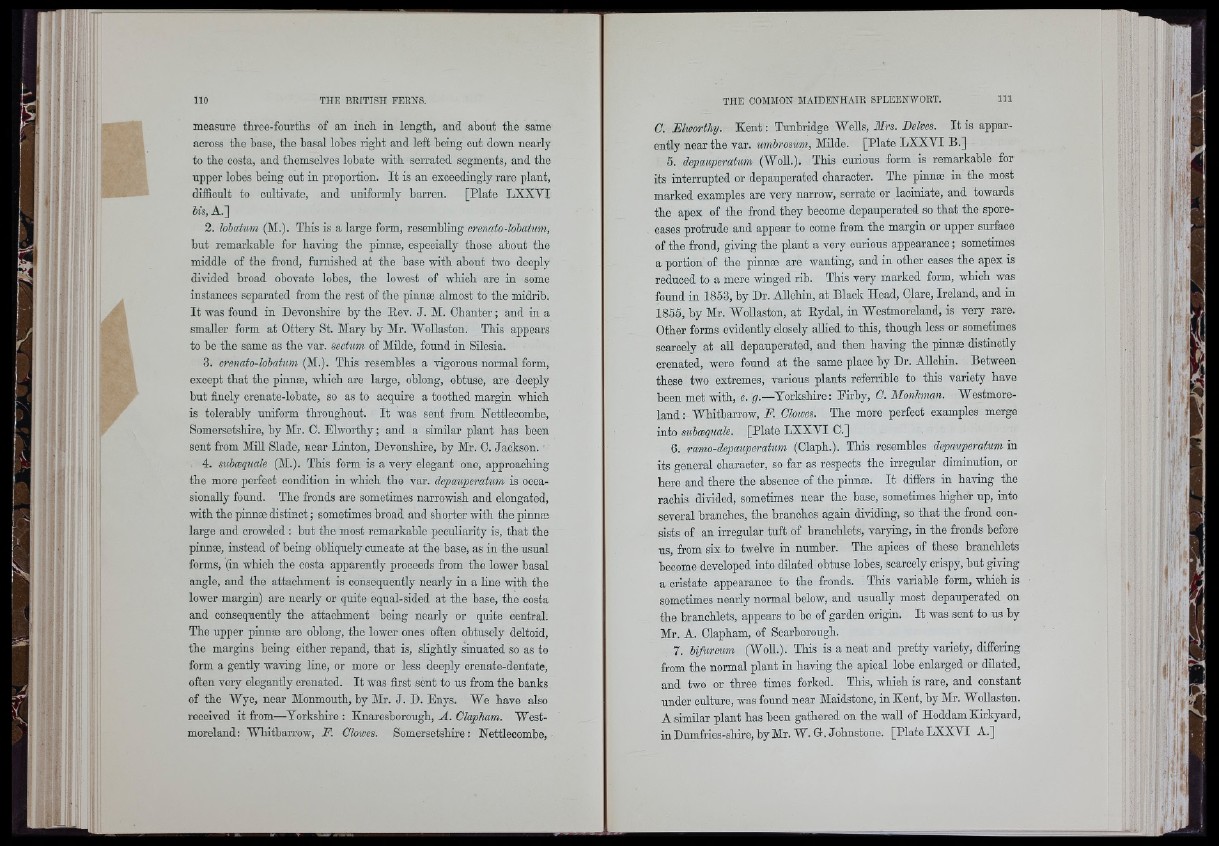
iri
fri
5;
■i. ' W '■
i ■
i I
1
î
7 t
110
measure three-fourths of an inch in length, and about the same
across tho base, the basal lobes right and left being cut down nearly
to tho costa, and themselyes lobate with serrated segments, and the
upper lobes being out in proportion. It is an exceedingly rare plant,
difficult to cultivate, and uniformly barren. [Plate LXXVI
Ms, A .]
2. lobatum (M.). This is a large form, resembling crenato-lohatim,
but remarkable for having the pinnæ, especially those about the
middle of the frond, furnished at the base with about two deeply
divided broad obovate lobes, the lowest of which are in some
instances separated from the rest of tho pinnæ almost to the midrib.
It was found in Devonshire by the Rev. J. M. Chanter ; and in a
smaller form at Ottery St. Mary by Mr. Wollaston. This appears
to be the same as the var. secttm of Milde, found in Silesia.
3. crenato-lobatum (M.). This resembles a vigorous normal form,
except that the pinnæ, which are large, oblong, obtuse, are deeply
but finely crenate-lobate, so as to acquire a toothed margin which
is tolerably uniform throughout. It was sent from Nettlecombe,
Somersetshire, by Mr. C. Elworthy ; and a similar plant has been
sent from MiU Slade, near Linton, Devonshire, by Mr. 0. Jackson.
4. subæquaîe (M.). This form is a very elegant one, approaching
the more perfect condition in which the var. depauperatum is occasionally
found. The fronds are sometimes narrowish and elongated,
with the pinnæ distinct ; sometimes broad and shorter with the pinnæ
large and crowded ; but the most remarkable peculiarity is, that the
pinnæ, instead of being obKquely cuneate at the base, as in the usual
forms, (in which the costa apparently proceeds from the lower basal
angle, and the attachment is consequently nearly in a Hne with the
lower margin) are nearly or quite equal-sided at the base, the costa
and consequently the attachment being nearly or quite central.
The upper pinnæ are oblong, the lower ones often obtusely deltoid,
the margins being either repand, that is, sKghtly sinuated so as to
form a gently waving hne, or more or less deeply crenate-dentate,
often very elegantly crenated. It was first sent to us from the banks
of the Wye, near Monmouth, by Mr. J. D. Enys. We have also
received it from—Yorkshire : Knaresborough, A. Clapham. Westmoreland:
Whitbarrow, F. Clowes. Somersetshire: Nettlecombe,
G. Elworthy. Kent : Tunbridge Wells, Mrs. Behes. It is apparently
near the var. umbrosum, Milde. [Plate LXXYI B.]
5. depauperatum (Well.). This curious form is remarkable for
its interrupted or depauperated character. The pinnæ in the most
marked examples are very narrow, serrate or laoiniate, and towards
the apex of the frond they become depauperated so that the spore-
cases protrude and appear to come from the margin or upper surface
of tho frond, giving the plant a very curious appearance ; sometimes
a portion of the pinnæ arc wanting, and in other cases the apex is
reduced to a mere winged rib. This very marked form, which was
found in 1853, by Dr. Allchin, at Black Head, Clare, Ireland, and in
1865, by Mr. WoUaston, at Rydal, in Westmoreland, is very rare.
Other forms evidently closely allied to this, though less or sometimes
soaroely at all depauperated, and then having the pinnæ distinctly
crenated, were found at the same place by Dr. AUchin. Between
these two extremes, various plants referrible to this variety have
been met with, e. ÿ.—Yorkshire: Eirby, C. Monkman. Westmoreland
: Whitbarrow, F. Clowes. The more perfect examples merge
into subæquaîe. [Plate LXXYI 0 .]
6. ramo-depauperatum (Claph.). This resembles depauperatum in
its general character, so far as respects the irregular diminution, or
here and there the absence of tho pinnæ. It differs in having the
raohis divided, sometimes near tho base, sometimes higher up, into
several branches, the branches again dividing, so that the frond consists
of an irregular tuft of branchlets, varying, in the fronds before
us, from six to twelve in number. The apices of these branchlets
become developed into dilated obtuse lobes, scarcely crispy, but giving
a cristate appearance to the fronds. This variable form, which is
sometimes nearly normal below, and usually most depauperated on
the branchlets, appears to be of garden origin. It was sent to us by
Mr. A. Clapham, of Scarborough.
7. Ufuroum (WoU.). This is a neat and pretty variety, differing
from the normal plant in having the apical lobe enlarged or dUated,
and two or three times forked. This, which is rare, and constant
under culture, was found near Maidstone, in Kent, by Mr. Wollaston.
A simUar plant has been gathered on the wall of Hoddam Kirkyard,
in Dumfries-shire, by Mr. W. G. Johnstone. [Plate LXXYI A.]
■4 t '■
I 'l
li"
i •
Si.';' .
if: I
■